Spring 2016 Fullerton College Anatomy 250 (Muscles)
Unlock all answers in this set
Unlock answersquestion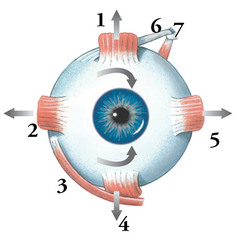
Lateral rectus

answer
ORIGIN: annulus of Zinn at the orbital apex INSERTION: 7 mm temporal to the limbus ACTION: abduction of the eyeball ANTAGONIST: medial rectus
question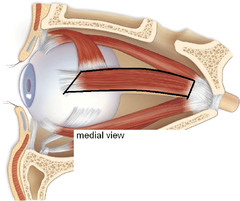
Medial rectus

answer
ORIGIN: annulus of Zinn at the orbital apex INSERTION: 5.5 mm medial to the limbus ACTION: adduction of the eyeball ANTAGONIST: lateral rectus
question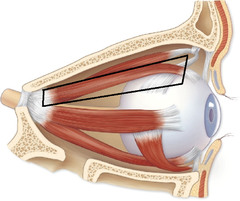
Superior rectus

answer
ORIGIN: annulus of Zinn at the orbital apex INSERTION: 7.5 mm superior to the limbus ACTION: elevation and abduction of the eyeball ANTAGONIST: inferior rectus
question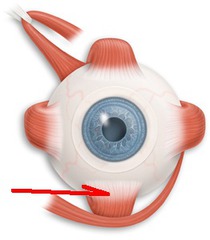
Inferior rectus

answer
ORIGIN: annulus of Zinn at the orbital apex INSERTION: 6.5 mm inferior to the limbus ACTION: depression and adduction of the eyeball ANTAGONIST: superior rectus
question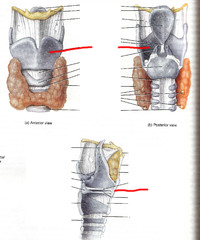
***Thyroid cartilage

answer
ORIGIN/INSERTION: larynx ACTION: protects vocal cords
question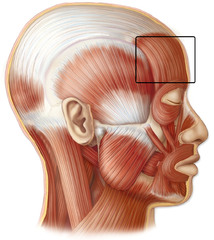
Epicranius (occipitofrontalis)

answer
ORIGIN: Galea aponeurotica (frontal belly); Occipital an temporal bones (occipital belly) INSERTION: Skin of eyebrows and root of nose (frontal belly); Galea aponeurotica (occipital belly) ACTION: with aponeurosis fixed, raises the eybrows (as in surprise); wrinkles forehead skin horizontally; fixes aponeurosis and pulls scalp posteriorly
question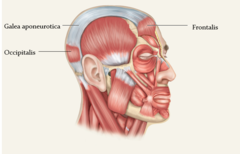
Occipital frontalis

answer
ORIGIN: Two occipital bellies and two frontal bellies. INSERTION: Galea aponeurosis ACTION: Raises eyebrows, wrinkles forehead
question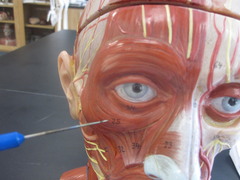
Orbicularis oculi

answer
ORIGIN: frontal and maxillary bones and ligaments around orbit INSERTION: tissue of eyelid ACTION: closes eye; various parts can be activated individually; produces blinking, squinting, and draws eyebrows inferiorly ANTAGONIST: Levator palpebrae superioris muscle
question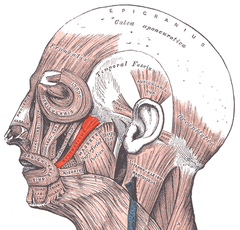
Zygomaticus

answer
ORIGIN: zygomatic bone INSERTION: skina nd muscle at corner of mouth ACTION: raises lateral corners of mouth upward (smiling muscle) ANTAGONIST: orbicularis oris
question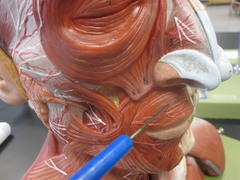
Orbicularis oris

answer
ORIGIN: arises indirectly from maxilla and mandible; fibers blended with fibers of other facial muscles associated with the lips INSERTION: encircles mouth; inserts into muscle and skin at angles of the mouth ACTION: closes lips; purses and protrudes lips; kissing and whistling muscles
question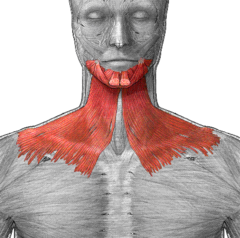
Platysma

answer
ORIGIN: fascia of chest (over pectoral muscles and deltoid) INSERTION: lower margin of mandible and skin and muscle at corner of the mouth ACTION: tenses skin of neck (e.g. during shaving); helps depress mandible; pulls lower lip back and down, i.e. produces downward sag of mouth ANTAGONIST: Masseter, Temporalis
question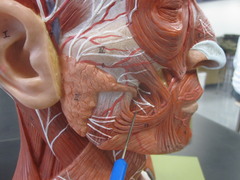
Buccinator

answer
ORIGIN: molar region of maxilla and mandible INSERTION: orbicular oris ACTION: compresses cheek (as in whistling and sucking); draws corner of mouth laterally; holds food between teeth during chewing well developed in nursing infants
question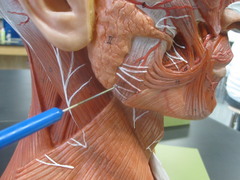
Masseter

answer
ORIGIN: zygomatic arch and zygomatic bone INSERTION: angle and ramus of mandible ACTION: Prime mover of jaw closure; elevates mandible
question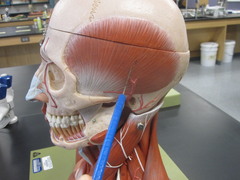
Temporalis

answer
ORIGIN: Temporal fossa INSERTION: Coronoid process of mandible via a tendon that passes deep to zygomatic arch ACTION: CLoses jaw; elevates and retracts mandible; maintains position of the mandible at rest; deep anterior part may help protract mandible ANTAGONIST: Platysma muscle
question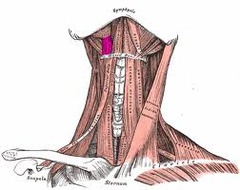
Hyoglossus

answer
ORIGIN: Hyoid INSERTION: side of tongue ACTION: depresses and retracts the tongue
question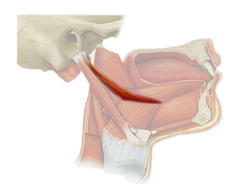
Styloglossus

answer
ORIGIN: styloid process of temporal bone INSERTION: lateral inferior aspect of tongue ACTION: retracts and elevates tongue
question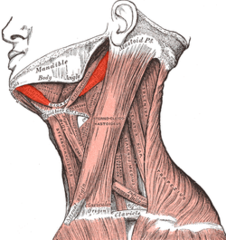
Digastric

answer
ORIGIN:lower margin of mandible (anterior belly) and mastoid process of the temporal bone (posterior belly) INSERTION: by a connective tissue loop to hyoid bone ACTION: open mouth and depress mandible; acting in concert, the digastric muscles elevate hyoid bone and steady it during swallowing and speech
question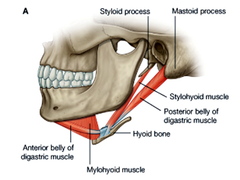
Stylohyoid

answer
ORIGIN: styloid process of temporal bone INSERTION: hyoid bone ACTION: Elevate and retract hyoid, thereby elongating floor of mouth during swallowing
question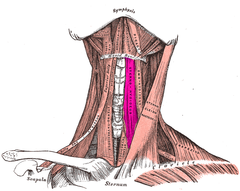
Sternohyoid

answer
ORIGIN: manubrium and medial end of clavicle ORIGIN: lower margin of hyoid bone ACTION: depresses larynx and hyoid bone if mandible is fixed
question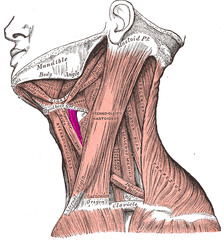
Thyrohyoid

answer
ORIGIN: thyroid cartilage INSERTION: Hyoid bone ACTION: depresses hyoid bone or elevates larynx if hyoid is fixed
question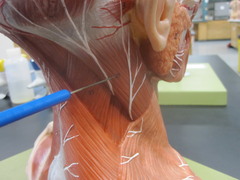
Sternocleidomastoid

answer
ORIGIN: Manubrium of sternum and medial portion of clavicle INSERTION: mastoid process of temporal bone and superior nuchal line of occipital bone ACTION: flexes and laterally rotates the head; simultaneous contraction of both muscles causes neck flexion, generally against resistance as when one raises head when lying on back; acting alone, each muscle rotates head toward shoulder on opposite side and tilts or laterally flexes head on its own side
question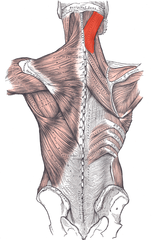
Splenius

answer
ORIGIN: ligamentum nuchae spinous process of vertebra C7-T6 INSERTION: Mastoid process of temporal bone and occipital bone (capitis); transverse processes of C2-C4 vertebrae (cervicis) ACTION: Extend the head; when splenius muscles on one side are activated, head is rotted and bent laterally towards the same side
question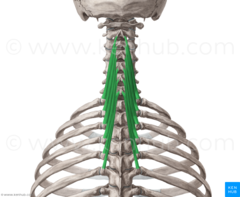
Semispinalis

answer
ORIGIN: Transverse processes of C7-T12 INSERTION: occipital bone (capitis) and spinous processes of cervical (cervicis) and thoracic vertebrae T1 to T4 (thoracis) ACTION: extends vertebral column and head and rotates them to opposite sides; acts synergisically with sternocleidomastoid muscle of opposite side
question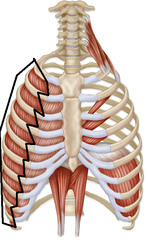
External intercostals

answer
ORIGIN: inferior border of rib above INSERTION: superior border of rib below ACTION:with first ribs fixed by scalene muscles, the external intercostals pull ribs toward one another to elevate rib cage; aid in inspiration; synergists of diaphragm ANTAGONIST: intercostales interni muscles
question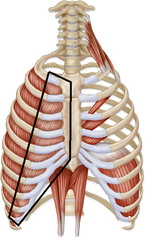
Internal intercostals

answer
ORIGIN: superior border of rib below INSERTION: inferior border of rib above ACTION: with 12th ribs fixed by quadratus lumborum, muscles of posterior abdominal wall, and oblique muscles of the abdominal wall, the internal intercostals draw ribs together and depress rib cage; aid in forced expiration; antagonistic to external intercostals ANTAGONIST: External intercostal muscles
question
Diaphragm

answer
ORIGIN: inferior internal surface of rib cage and sternum, costal cartilages of last six ribs, and lumbar vertebrae INSERTION: Central tendon ACTION: prime mover of inspiration; flattens on contraction, increasing vertical dimensions of thorax; when strongly contracted, dramatically increases intrabdominal pressure ANTAGONIST: internal intercostals
question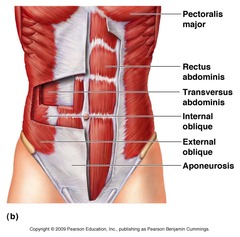
Transversus abdominis

answer
ORIGIN: inguinal ligament, lumbar fascia, cartilages of last 6 ribs; iliac crest INSERTION: linea alba, pubic crest ACTION: compresses abdominal contents
question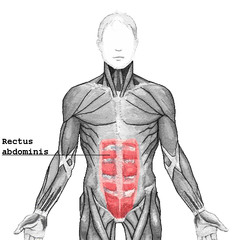
Rectus abdominis

answer
ORIGIN: Pubic crest and symphysis INSERTION: xiphoid process and costal cartilages of ribs 5-7 ACTION: flex and rotate lumbar region of vertebral column; fix and depress ribs, stabilize pelvis during walking, increases intra-abdominal pressure; used in sit-ups/curls ANTAGONIST: Erector spinae
question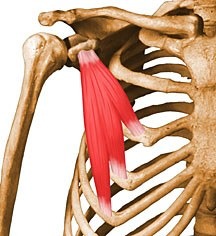
Pectoralis minor

answer
ORIGIN: anterior surfaces of ribs 3-5 (or 2-4) INSERTION: caracoid process pf scapula ACTION: with ribs fixed, draws scapula forward and downward; with scapula fixed, draws rib cage superiorly
question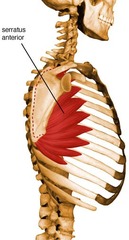
Serratus anterior

answer
ORIGIN: by a series of muscle slips from ribs 1-8 (or 9) INSERTION: entire anterior surface of vertebral border of scapula ACTION: rotates scapula so that its inferior angle moves laterally and upward; prime move to protract and hold scapula against chest wall; raises point of shoulder; important role in abduction and raising of arm and in horizontal arm movements (pushing, punching); called \"boxer's muscle\" ANTAGONIST: Rhomboid major, Rhomboid minor, Trapezius
question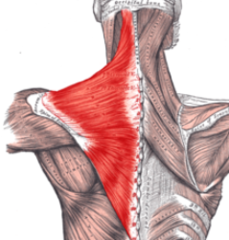
Trapezius

answer
ORIGIN: ocipital bone, ligamentum nuchae, and spine of C7 and all thoracic vertebrae INSERTION: a continuous insertion along acromion and spine of scapula and lateral third of clavicle ACTION: stabilizes, raises, retracts, and rotates scapula; middles fivers retract (adduct) scapula; superior fibers elevate scapula (as in shrugging shoulders) or can help extend head when scapula is fixed; inferior fibers depress scapula (and shoulder) ANTAGONIST: serratus anterior muscle, Latissimus dorsi
question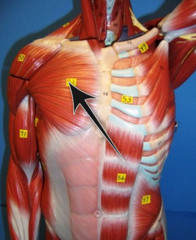
Pectoralis major

answer
ORIGIN: sternal end of clavicle, sternum, cartilage of ribs 1-6 (or 7) , and aponeurosis of external oblique muscle INSERTION: fibers converge to insert by a short tendon into greater tubercle of humerus ACTION: prime mover of arm flexion; rotates arm medially; adducts arm against resistance; with scapula (and arm) fixed, pulls rib cage upward, and thus can help in climbing, throwing, pushing, and in forced inspiration
question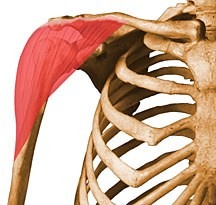
Deltoid

answer
ORIGIN: embraces insertion of the trapezius; lateral third of clavicle; acromion and spine of scapula INSERTION: deltoid tuberosity of humerus ACTION: prime mover of arm abduction when all its fibers ontract simoutaneously; antagonist of pectoralis major and latissimus dorsi, which adducts the arm; if only anterior fibers are active, can act powerfully in flexion and medial rotation of humerus, and is therefor synergist of pectoralis major; if only posterior fibers are active, causes extension and lateral rotation of arm; active during rhythmic arm swinging movements during walking ANTAGONIST: Latissimus dorsi
question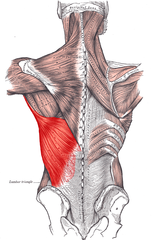
Latissimus dorsi

answer
ORIGIN: indirect attachment via thoracolumnar fascia into spines of lower six thoracic vertebrae, lumbar vertebrae, lower 3 or 4 ribs, and iliac crest INSERTION: spirals aroudn teres major to insert in floor of intertubercular sulcus of humerus ACTION: prime mover of arm extension; adduction and medial rotation at shoulder; it plays an important role in bringing the arm down in a power stroke as in striking a blow, hammering, and swimming; with arms reaching overhead, it pulls the rest of the body upward and forward ANTAGONIST: Deltoid
question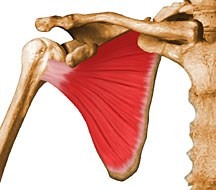
Subscapularis

answer
ORIGIN: subscapular fossa of scapula INSERTION: Lesser tubercle of humerus ACTION: chief medial rotator of humerus; assisted by pectoralis major; helps to hold head of humerus in glenoid cavity, thereby stabilizing shoulder joints
question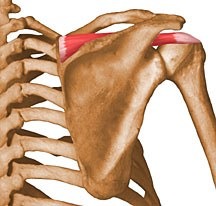
Supraspinatus

answer
ORIGIN: supraspinous fossa of scapula INSERTION: superior part of greater tubercle of humerus ACTION: initiates abduction; stabilizes shoulder joint; helps to prevent downward dislocation of humerus, as when carrying a heavy suitcase
question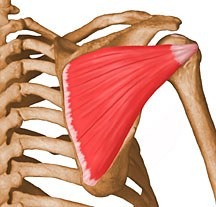
Infraspinatus

answer
ORIGIN: infraspinous fossa of the scapula INSERTION: greater tubercle of humerus posterior to insertion of supraspinatus ACTION: rotates humerus lateay; helps to hold head of humerus in glenoid cavity, stabilizing the shoulder joint
question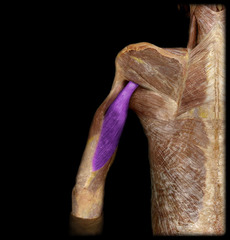
Triceps brachii

answer
ORIGIN: Long head: infraglenoid tubercle of scapula Lateral head: posterior shaft of humerus Medial head: posterior humeral shaft distal to radial groove INSERTION: by common tendon into olecranon process of ulna ACTION: Epowerful forearm extensor (prime mover, particularly medial head); antagonist of forearm flexors; long and lateral heads mainly active in extension against resistance; long head tendon may help stabilize shoulder joint and assist in arm adduction ANTAGONIST: Biceps brachii muscle
question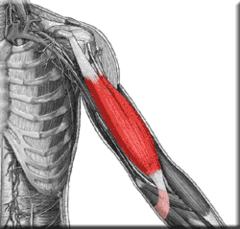
Biceps brachii

answer
ORIGIN: Short head: coracoid process Long head: supraglenoid tubercle and lip of glenoid cavity; tendon of long head runs within cpsule and descends into tubercular sulcus of humerus INSERTION: by common tendon into radial tuberosity ACTION: Flexes elbow joint and supinates forearm; these actions usually occur at same time (e.g. when you open a bottle of wine it turns the corkscrew and pulls the cork); weak flexor of arm at shoulder ANTAGONIST: Triceps brachii muscle
question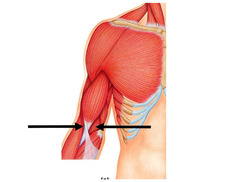
Brachialis

answer
ORIGIN: front of distal humerus; embraces insertion of deltoid muscle INSERTION: coronoid process of ulna and capsule of elbow joint ACTION: a major forearm flexor (lifts ulna as biceps lift the radius)
question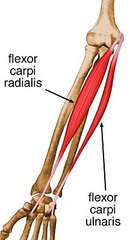
Flexor carpi radialis

answer
ORIGIN: medial epicondyle of humerus INSERTION: base of second and third metacarpals; insertion tendon easily seen and provides guide to position of radial artery (used for pulse taking) at wrist ACTION: powerful flexor of wrist ANTAGONIST: Extensor carpi radialis brevis muscle and extensor carpi radialis longus muscle
question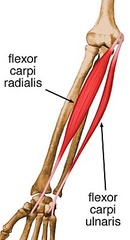
Flexor carpi ulnaris

answer
ORIGIN: medial epicondyle of humerus; olecranon process and posterior surface of ulna INSERTION: pisiform and hamate bones and base of fifth metacarpal ACTION: Powerful flexor of writ; also adducts hand in concert with extensor carpi ulnaris (posterior muscle); stabilizes extension
question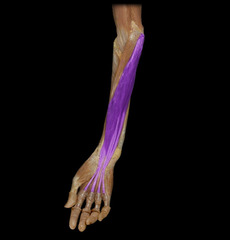
Flexor digitorum superficialis

answer
ORIGIN: medial epicondyle of the humerus, coronoid process of ulna; shaft of radius INSERTION: by four tendons into middle phalanges of fingers 2-5 ACTION: flexes wrist and middle phalanges of fingers 2-4; the important finger flexor when speed and flexion against resistance are required ANTAGONIST: Extensor digitorum muscle
question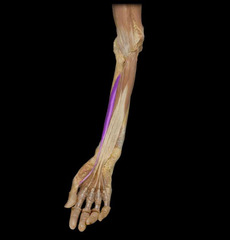
Flexor pollicis longus

answer
ORIGIN: anterior surface of radius and interosseous membrane INSERTION: distal phalanx of thumb ACTION: flexes distal phalanx of thumb ANTAGONIST: Extensor pollicis longus muscle, Extensor pollicis brevis muscle
question
Extensor carpi radialis longus

answer
ORIGIN: lateral supracondylar ridge of humerus INSERTION: base of metacarpal ACTION: extends wrist in conjunction with the extensor carpi ulnaris and abducts wrist in conjunction with the flexor carpi radialis ANTAGONIST: Flexor carpi ulnaris muscle
question
Extensor digitorum

answer
ORIGIN: lateral epicondyle of humerus INSERTION: by four tendons into extensor expansions and distal phalanges of fingers 2-5 ACTION: prime mover of finger extension; extends wrist; can abduct (flare) fingers ANTAGONIST: Flexor digitorum superficialis muscle, Flexor digitorum profundus muscle
question
Extensor carpi ulnaris

answer
ORIGIN: lateral epicondyle of humerus and posterior border of ulna INSERTION: base of 5th metacarpal ACTION: extends wrist in conjunction with the extensor carpi radialis and adducts writ in conjunction with flexor carpi ulnaris ANTAGONIST: Flexor carpi radialis
question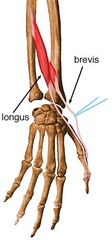
Extensor pollicis brevis and longus

answer
ORIGIN: dorsal shaft of radius and ulna; interosseous membrane INSERTION: base of proximal (brevis) and distal (longus) phalanx ACTION: extends thumb ANTAGONIST: Flexor pollicis longus muscle, Flexor pollicis brevis muscle
question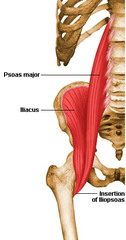
Iliacus

answer
ORIGIN: iliac fossa, ala of sacrum INSERTION: lesser trochanter of femur via iliopsoas ACTION: iliopsoas is the prime mover in thigh flexion and in flexing trunk (as when bowling) ANTAGONIST: Gluteus maximus
question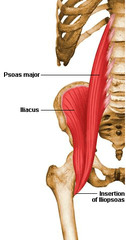
Psoas Major

answer
ORIGIN: anterior superior iliac spine INSERTION: winds around medial aspect of knee an inserts into medial aspect of proximal tibia ACTION: iliopsoas is the prime mover in thigh flexion and in flexing trunk (as when bowling); also causes lateral flexion of vertebral column; important postural muscle ANTAGONIST: Gluteus maximus
question
Sartorius

answer
ORIGIN: Anterior superior iliac spine INSERTION: winds around medial aspect of knee and inserts into medial aspect of proximal tibia ACTION: Flexes, abducts, and laterally rotates thigh; flexes knee (weak) as in a soccer kick; helps produce the cross legged position
question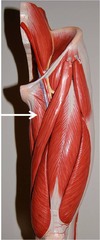
Adductor longus

answer
ORIGIN: pubis near pubic symphysis INSERTION: linea aspera ACTION: adducts, flexes, and medially rotates thigh
question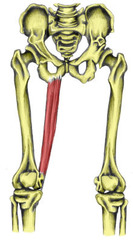
Gracilis

answer
ORIGIN: inferiro ramus and body of pubis and adjacent ischial ramus INSERTION: medial surface of tibia just inferior to its medial condyle ACTION: adducts thigh, flees and medially rotates leg, especially during walking
question
Rectus femoris

answer
ORIGIN: anterior inferior iliac spine and superiors margin of acetabulum INSERTION: patella and tibial tuberosity via patellar ligament ACTION: Extends knee and flexes thigh at hip ANTAGONIST: Hamstring
question
Vastus lateralis

answer
ORIGIN: Greater trochanter, Intertrochanteric line, Linea aspera INSERTION: patella and tibial tuberosity via patellar ligament ACTION: extends and stabilizes knee ANTAGONIST: Hamstring
question
Vastus medialis

answer
ORIGIN: linea aspera, medial supracondylar line, intertrochanteric line INSERTION: patella and tibial tuberosity via patellar ligament ACTION: Extends knee; inferior fibers stabilize patella
question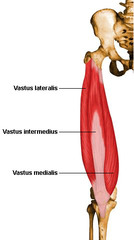
Vastus intermedius

answer
ORIGIN: anterior and lateral surfaces of proximal femur shaft INSERTION: patella and tibial tuberosity via patellar ligament ACTION: Extends knee
question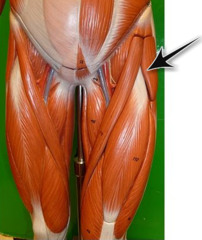
Tensor fasciae latae

answer
ORIGIN: anterior aspect of iliac crest and anterior superior iliac spine INSERTION: iliotibial tract ACTION: Steadies trunk on thigh by making iliotibial tract taut; flexes and abducts thigh; rotates thigh medially
question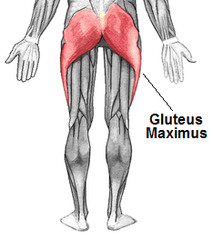
Gluteus maximus

answer
ORIGIN: dorsal ilium, sacrum, and coccyx INSERTION: gluteal tuberosity of femur; iliotibial tract ACTION: major extensor of thigh; complex, powerful, and most effective when thigh is flexed and fore is necessary, as in rising from a forward flexed position and in thrusting the thigh posteriorly in climbing stairs and running, generally inactive during standing and walking; laterally rotates and abducts thigh ANTAGONIST: Iliacus, psoas major and psoas minor
question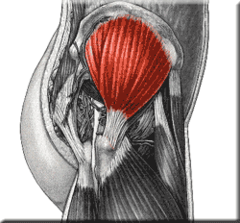
Gluteus medius

answer
ORIGIN: between anterior and posterior gluteal lines on lateral surface of ilium INSERTION: by short tendon into lateral aspect of greater trochanter of femur ACTION: abduction of the hip; preventing adduction of the hip. Medial rotation of thigh. ANTAGONIST: adductors
question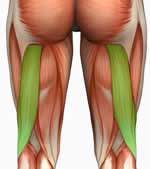
Bicep femoris

answer
ORIGIN: ischial tuberosity (long head); linea aspera, lateral supracondylar line, and distal femur (short head) INSERTION: common tendon passes downward and laterally (forming lateral border of popliteal fossa) to insert into head of fibula and lateral condyle of tibia ACTION: extends thigh and flexes knee; laterally rotates leg, especially when knee is flexed ANTAGONIST: Quadriceps muscle
question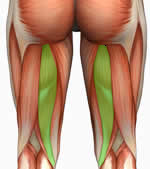
Semitendinosus

answer
ORIGIN: ischial tuberosity in common with long head of biceps femoris INSERTION: medial aspect of upper tibial shaft ACTION: Extends thigh and flexes knee; medially rotates leg ANTAGONIST: Quadriceps muscle
question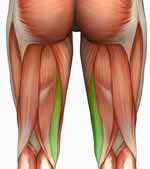
Semimembranosus

answer
ORIGIN: ischial tuberosity INSERTION: Medial condyle of tibia; through oblique ligament to lateral condyle of femur ACTION: Extends thigh and flexes knee; medially rotates leg ANTAGONIST: Quadriceps muscle and Tensor fasciae latae
question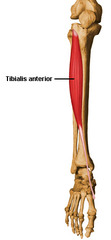
Tibialis anterior

answer
ORIGIN: lateral condyle and upper two thirds of tibial shaft; interosseous membrane INSERTION: by tendon into inferior surface of medial cuneiform and first metatarsal bone ACTION: prime mover of dorsiflexion; inverts foot; assists in supporting medial longitudinal arch of foot ANTAGONIST: Fibularis longus, Gastrocnemius, Soleus, Plantaris, Tibialis posterior
question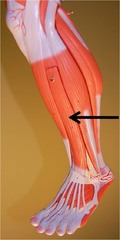
Extensor digitorum longus

answer
ORIGIN: lateral condyle of tibia; proximal three-fourths of fibula; interosseous membrane INSERTION: Middle and distal phalanges of toes 2-5 via extensor expansion ACTION: Prime mover of tie extension (acts mainly at metatarsophalangeal joints); dorsiflexes foot ANTAGONIST: Flexor digitorum longus, Flexor digitorum brevis
question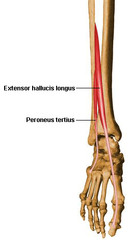
Extensor hallucis longus

answer
ORIGIN: anteromedial fibula shaft and interosseous membrane INSERTION: tendon inserts on distal phalanx of great toe ACTION: Extends great toe; dorsiflexes foot ANTAGONIST: Flexor hallucis longus, Flexor hallucis brevis
question
Extensor (perenous) longus

answer
ORIGIN: Head and upper portion of lateral side of fibula INSERTION: by long tendon that curves under foot to first metatarsal and medial cuneiform ACTION: plantarflexion, eversion, support arches ANTAGONIST: Tibialis anterior muscle, T.A. does Inversion and Dorsiflexion
question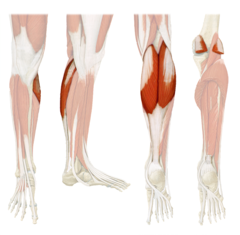
Gastrocnemius

answer
ORIGIN: by two heads from medial and lateral condyles of femur INSERTION: posterior calcaneous via calcaneal tendon ACTION: plantar flexes foot when when knee is extended; because it also crosses knee joint; it can flex knee when foot is dorsiflexed ANTAGONIST: Tibialis anterior muscle
question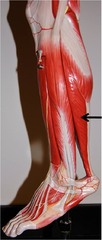
Soleus

answer
ORIGIN: extensive cone-shaped origin from superior tibia, fibula, and interosseous membrane INSERTION: posterior calcaneous via calcaneal tendon ACTION: plantar flexes foor; important locomotor and postural muscle during walking, running, and dancing ANTAGONIST: tibialis anterior
question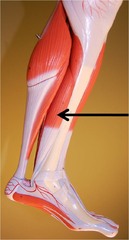
Flexor digitorum longus

answer
ORIGIN: extensive origin on the posterior tibia INSERTION: tendon runs behind medial malleolus and splits to insert into distal phalanges of toes 2-5 ACTION: Plantar flexes and inverts foot; flexes toes; helps foot \"grip\" ground ANTAGONIST: Extensor digitorum longus, Extensor digitorum brevis
question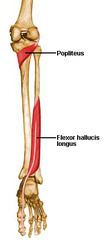
Flexor hallucis longus

answer
ORIGIN: middle part of shaft of fibulal interosseous membrane INSERTION: tendon runs under foot to distal phalanx of great toe ACTION: plantar flexes and inverts foot; flexes great to at all joints; \"push off\" muscle during walking ANTAGONIST: Extensor hallucis longus muscle
question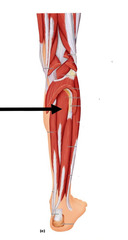
Tibialis posterior

answer
ORIGIN: superior tibia nd fibula and interosseous membrane INSERTION: tendon passes behind medial malleolus and under arch of footl inserts into several tarsals and metatarsals 2-4 ACTION: Prime mover of goot inversion; plantar flexes foot; stabilizes medial longitudinal arch of foot (as during ice skating) ANTAGONIST: Fibularis brevis



